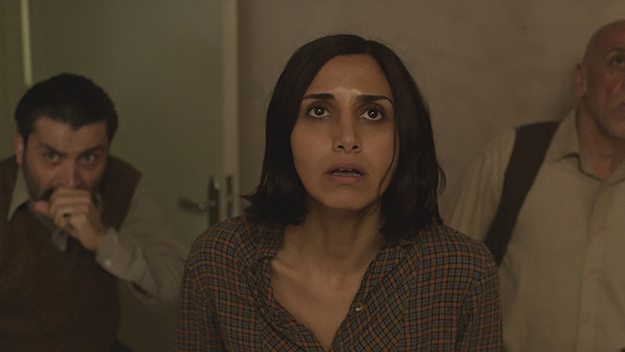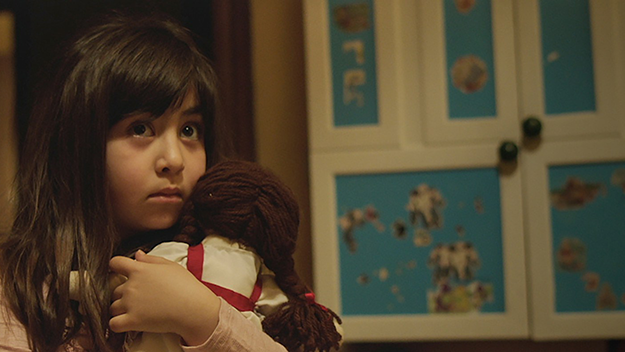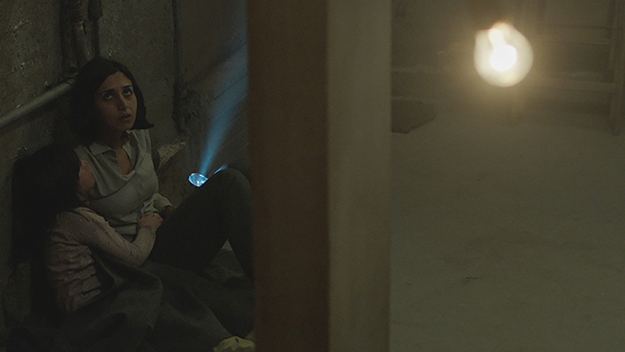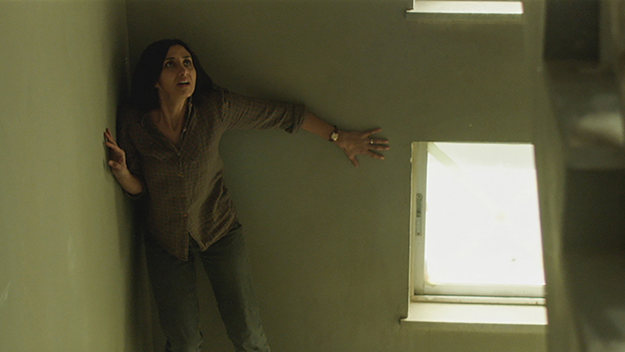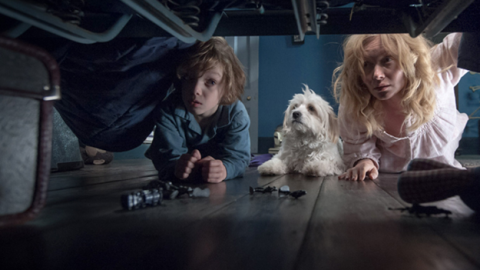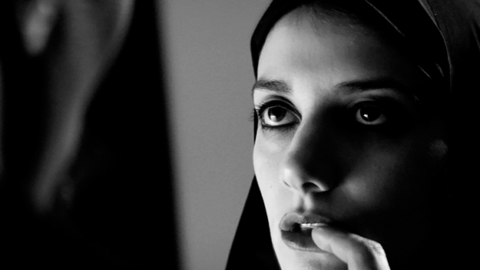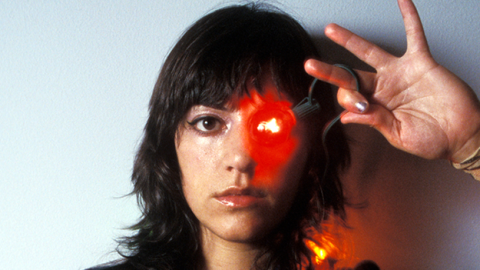ND/NF Interview: Babak Anvari
Infused with autobiographical elements, Babak Anvari’s debut feature is a terrifying allegory of the 1980-88 Iran-Iraq War, a now often overlooked conflict that shaped much of this London-based Iranian filmmaker’s early childhood. A constantly shifting expressionistic nightmare, Under the Shadow centers upon Shideh (Narges Rashidi), a frustrated mother unable to fulfill her career aspirations because of her former political activism. When her doctor husband is drafted, Shideh is left alone with her daughter Dorsa and must protect her from supernatural phenomena brought upon their Tehran apartment by a missile attack. At first skeptical of ghost stories, Shideh slowly realizes that her home is haunted and gets sucked into a web of paranoia wherein malevolent djinn mess with her mind. Like any insightful work of horror, Anvari’s film leaves it to the viewer to decide whether the supernatural threat is a shared reality or no more than a psychosomatic symptom—a harrowing projection of the protagonist’s deranged psyche.
Prior to the New Directors/New Films opening-night screening of Under the Shadow, FILM COMMENT sat down with Anvari in Tribeca to discuss the genesis of his politically charged, spine-chilling debut and the development of his method as a first-time feature director.
In Under the Shadow, the supernatural horror that erupts in the household also functions as a metaphor for the horrors of war happening outside. Did horror feel like the obvious choice of genre to depict those apocalyptic times?
Yes. From day one that I started thinking about the idea, I knew that I was going to go down the horror/psychological thriller path. That was such an intense, dark time—all wars are dark—and married to that was all the post-revolution turmoil. I thought it was a great setting for a horror and psychological thriller, especially because that era hasn’t been explored before. So I thought this script could be quite original.
I started with the story. The story comes from a very personal place. I was born right in the middle of the Iran-Iraq war in Tehran, so I spent the first five years of my life during wartime. So it was basically about tapping into my childhood memories and remembering all the stress and anxiety involved. I thought that you could portray that in a sort of metaphorical way but going down the horror road.
You’ve said in an interview that you had trouble sleeping as a child and that your mother later blamed herself for it. In fact, conversations with her about those days were in part what triggered the idea of this film. I assume you tried to inhabit your mother’s psyche when developing Shideh. Did you consult her at all during the writing stage?
I talked to both of my parents a lot, especially my mom. She read the many drafts of the script as I was working my way through it. It’s not an autobiography obviously—it’s more of a work of fiction—but the whole idea came from my own experiences. That’s the reason I chose the mother as the main character because it started with that conversation that I had with my mom. Even for research—because I was a child during that time, I couldn’t remember a lot—talking to her and my dad was really helpful. They reminded me of the nitty-gritty details of that time that helped me make the story more authentic and connect to my mother’s point-of-view.
My mom saw the film and loved it. She got really emotional actually. Obviously, that character is not my mom but she unconsciously drew a link.
The film traces Shideh’s transformation from a pragmatic woman of science into an anxious and mentally disturbed protagonist drifting into delirium. Yet even when she loses her points of reference, Shideh keeps fighting and refuses to give in to the supernatural forces that want to disarm her. How did you prepare Narges Rashidi for the battle?
We started with ongoing conversations about the character and her background: where she’s coming from, what’s her relationship with her mother, which in the film we realize had a huge influence on her—when the film starts, she has been dead for six months. Because of the budget of the film and the time constraint, I didn’t have a long time to rehearse with her, but Narges is such a great technical actress. She’s L.A.-based and I’m in London, so for two months we used to Skype every week, read the script and go through the background notes. And when we were in Jordan to shoot the film, we spent two days right before the shoot, not rehearsing the scenes in the film but going through the whole action. The rehearsal period for me was just going through the character’s background and the stuff that you don’t see in the film, because if you get those right then the character becomes three-dimensional, and then you do the blocking and everything else on the set.
That was my way of working, and having her and Bobby Naderi who plays her husband and Avin [Manshadi] who plays the little girl, all sitting together and being comfortable with each other. They needed to portray a realistic family and I had to make the chemistry really work between them. Since it was a low-budget film, it was about trying to get the best out of the actors in a limited time.
A big chunk of the film shows Shideh sleeping, and the evolution of the camerawork from one bedroom scene to the next reflects her gradual loss of sanity. You start with these conventional straight-on shots and move on to eerie compositions, literally flipping the camera upside down and rocking it when Shideh is first visited by the djinn. How did you approach the visual progression in the film? Did you want to inject this idea of voyeurism, almost as if we were watching certain scenes from the djinn’s perspective?
The whole idea was to have the camera, not in a voyeuristic way in the sense that it’s djinn’s POV, but more like you’re a fly on the wall. The camera is there, it’s one of the characters just following Shideh around. We’re more or less in Shideh’s shoes throughout the film and she’s almost in 98 percent of the film, in every scene except one. The idea was that the camera is there, so the film starts as if we’re another character, an invisible character, and we’re like: “Okay, we want to follow this lady and learn about her.” So I guess, yeah, now that I’m talking about it, it is very voyeuristic—a third-eye kind of thing. The film starts off as being a bit more objective but then bit by bit we enter Shideh’s mind, and that’s when the camera movements start getting a bit freaky and expressionistic. And we tried to experiment more with the camera movements when we were more inside her psyche later on in the film.
Did you nail down all the camera movements with your cinematographer before you started shooting?
Yes, 100 percent. Basically, my DP Kit Fraser is one of my oldest friends—I met him at film school 13 years ago so we’ve been friends for over 13 years, and we’ve worked a lot together. He was the first person whom I told about the idea of Under the Shadow before I even started writing the script. So he was involved from the start and as I was writing the script, we used to always talk about the look of the film and what we’re after. It was great because by the time we got to preproduction, we knew the feel of the film and the look we wanted to achieve and then we spent two weeks in preproduction just me and him on location talking about all the camera movements. So we were fully prepared once we started shooting. Especially again because it was low-budget and we only had 21 days to shoot, we had to be as efficient as possible and know exactly what we wanted to do. All of that was fully planned.
We experimented in the sense that while we were blocking it, we were like “How about trying this? How about trying that?” and then on the day, we were flexible. But we had limited time so we didn’t have a lot of time to just experiment. So it was basically “Let’s go with this idea and hopefully it’s going to work! Fingers crossed.” It’s just having that confidence as well and trusting your vision and thinking that if I’m doing everything right, it should work. And I know it’s a bit risky but we went for it.
The progressive deterioration of the apartment is strongly reminiscent of that of Trelkovsky in Polanski’s The Tenant. In a previous interview, you mention the influence of Rosemary’s Baby and Repulsion—the latter of which is clearly echoed through that shot of hands smashing the window and grabbing Shideh—but the whole plot with the neighbors and Shideh’s sense of paranoia and fear of incompetence kept reminding me of The Tenant in particular. Her world falls apart and her identity is shattered in a similar way.
Yes, exactly. I think when it comes to getting inspired by films, it’s not about sitting there and saying: “I want to take this. I want to take that.” You basically watch the film and let it affect you, and however it affects you, you keep that in mind and try to do similar things. So it’s about using those elements but making them your own. It’s really hard for me to tell what I got from The Tenant or Repulsion or Rosemary’s Baby. It was just the general mood of it and the whole idea of everything being set in an apartment. That came from Polanski’s “Apartment Trilogy” because all three of those films are set in a claustrophobic, constrained sort of space. And all three of them are about this idea of your home twisting into something else and becoming a very threatening place, even though it’s supposed to be a very comfortable and safe place. And I think that’s a universal idea, it’s something that creeps everyone out around the world.
How did you work with the production designer to achieve that transformation of the space from safe, comfortable home to chaotic battlefield?
We met the production designer in Jordan, Nasser Zoubi. Me, my DP, and him sat down and talked about the look and what we were trying to achieve, and I had folders and folders of reference pictures of those days in Tehran. So I shared them with him. And the fact that he was also from a Middle-Eastern background helped because he understood the world. So I did a lot of research—like I said, I had folders and folders and folders—so we sat down and went through it. Every apartment has a unique feel. The majority of the film is set in Shideh’s apartment but with the neighbors, we discussed how we could make their apartments look different and make them represent the character.
What was your collaboration like with Avin Manshadi, who plays Dorsa and who had never acted before? How did you get her to reach the aggressive heights she reaches when, for instance, she’s banging on the neighbors’ door, claiming her doll from the djinn?
It was about making sure that she’s in a safe environment, and Narges, the main actress, and I spent a lot of time talking about how we can work with her to get the best out of her. She really also respected Narges, who plays her mother and she’s a non-actress. The key thing for us was to find a child who’s super smart and creative and who’s comfortable with that process and is comfortable with the camera and being in such a crowded, crazy environment. And after auditioning many children, as soon as she walked in, I was like: “She’s the one.”
What did you have Avin do in the audition?
I was auditioning many children, but before she even came in, I saw a video of her doing this presentation at school about the Great Fire of London. And even watching that video, I knew she was great—she was telling the story about the fire with a very somber expression. And the day she walked in, I didn’t really ask her to do anything specific—we did some of the scenes together and then… She wasn’t shy and she was listening to me and she was taking in directions and those were the very key elements. She instantly trusted me, and those were the things I was looking for in the child.
Was she familiar with djinn stories before the film?
Not really. I mean, she knew about ghosts. I kept telling her: “Just remember. Don’t get too scared. This is like a role-play. Don’t get too wrapped up. Everything just came out of my head and this is not real. So let’s just like have fun and role-play.” And like I said, it was all about making her feel safe on the set and create that atmosphere of trust. When she arrived, she was a bit giggly and shy at first but then literally by the end of the first week, she was acting like a professional actress. She was like “Where is my mark?” and all, which literally shows how clever and smart she was. She was looking at all the adult actors, especially Narges, and trying to copy her and trying to see how she works. So it was really interesting to see that.
She was trying to understand the rules of the game.
Exactly. We were very lucky to have such a brilliant, bright child on board. During the rehearsals with her, we didn’t necessarily rehearse scenes. It was mainly about playing with her and just doing some role-playing to see if she can take directions and again build that trust with her. We were playing like “Three Little Pigs” and I would be the wolf. So it was nothing from the script and was meant to get her to feel comfortable with me.
You shot Under the Shadow in Jordan because of filmmaking restrictions in Iran. Has the film been released in Iran? How do you expect it to be received?
Hopefully well. I’m pretty sure it’s not going to be screened there because the authorities don’t necessarily like films being made outside Iran about Iran because they don’t really have much control over them, even though the film doesn’t have anything offensive in it. At least, I don’t think it does. Hopefully people might get their hands on it and watch it. I really hope the Persian community—anywhere in the world, not just in Iran—relates to it. I made this film for the Iranian audience as well as international audiences and I was trying to use the genre tropes and tell an entertaining story and use that as a hook to introduce that side of Iran to the international audiences and tell them about the Iran-Iraq War, which is a period that not many people know about outside of Iran.
Do you think the authorities would condemn your decision to film Narges Rashidi without a headscarf indoors the way Shideh’s running outdoors without a hijab is condemned by the haji in the film?
That was the reason why I didn’t even think about shooting in Iran because I wanted to tell my story as honestly as possible without restriction and censorship.
How did you come up with the image of the veiled djinn?
There’s a clue in the film about the pattern on the veil of the djinn, which I don’t want to actually spoil. There is a reason for that. It’s one of those things that I think is best for the audience to have their own interpretation of. The “Why does it take that form? What does it mean?” should be left to the audience to answer.
It’s natural for audience members to be scared by Under the Shadow because you give us the sights and sensations of horror. How did you create the same kind of horror on set for the actors, since horror at its core is so much about manipulating the environment. Did you shoot mostly in chronological order?
Not necessarily, again because of time and money constraints. I think that with a very well-trained actor like Narges, you don’t really need to manipulate or create that atmosphere to physically scare her. You use that trick for non-actors but someone who is trained has the ability to switch in and out and that’s really what I respect in good actors—you just need to make them feel safe and as a filmmaker, you need to build that trust and have that relationship with them that allows you to communicate your vision to them. So I didn’t have to manipulate the environment.
As an Iranian filmmaker who grew up in Iran but trained in England and has been living there ever since, where would you position yourself in relation to Iranian cinema?
It’s a tough one because right now I’m based in the U.K., my home is London, and Under the Shadow was a U.K. film rather than a film made in Iran. So I would say I’m a filmmaker of that background and I will always be a filmmaker of that background and I will always respect and love that, but I don’t necessarily like to classify myself or limit myself to just one region. I want to be able to tell stories that have a universal feel and that anyone from anywhere around the world can relate to. I don’t necessarily want to be bound by geography if that makes sense.
Did you feel as if you had a moral duty to make a film about your country?
I didn’t feel like it was a moral duty that I had to make this film about Iran. I felt like I wanted to tell this story because I was passionate about telling it and it excited me and I thought that it was the type of story that I could use to introduce the world to the other side of Iran—the side that the media doesn’t necessarily show to you in the Western world. It wasn’t necessarily a moral duty, it was more of an itch. I just had to tell this story, I was passionate about it, and it comes from a personal place so that was my drive. And from now on, everything that I do, even if it’s not in Farsi or about Iran, I need to always have that passion about it, because otherwise there’s no point in making films. You need that excitement—you put so much time and effort in every film that you need to have something that is driving you.
Filmmaking, like acting, needs to come from the guts.
Yeah. It doesn’t necessarily have to be about something you’ve experienced yourself—well, it needs to come from the inside, even if it’s not necessarily about your country, it could be an emotion that you’re very familiar with. Childhood is the foundation of everything so whatever you end up becoming later on in life, comes from your childhood. That’s when your character starts forming.



